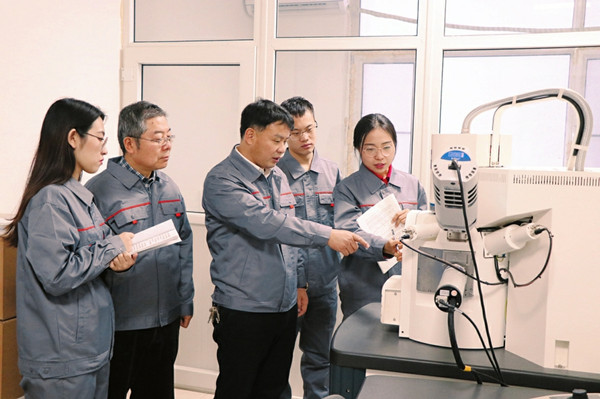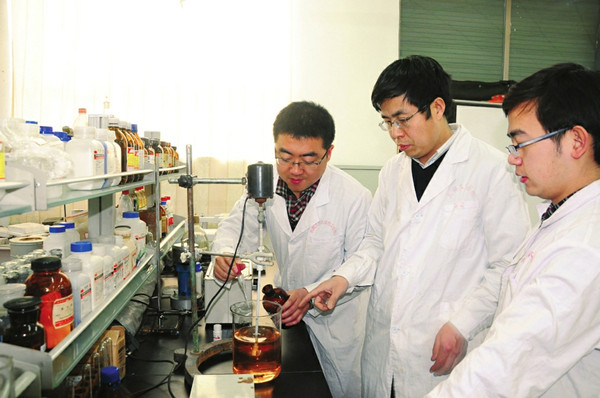Province prioritizes greater innovation in IT
Updated: 2021-07-23

Ma Lifeng (center), a professor from the School of Mechanical Engineering at Taiyuan University of Science and Technology, instructs his team members in research on flexible rolling sheet metal technology. [Photo by Wang Pei for China Daily]
More cooperation among universities, govt and enterprises key to success
One of China's pioneering colleges specializing in the information technology application innovation industry was founded at the North University of China in Shanxi province in April thanks to the close cooperation between the university and prominent IT products developer 100 Trust.
The college will support the local IT application innovation industry, covering training and scientific research, local officials said.
The IT application innovation industry is one of 14 strategic emerging sectors in the province. Others include big data, semiconductors and the photovoltaic industry.
The 14 emerging industries are becoming a core driving force for Shanxi's high-quality development and transformation, according to the province's development plan for emerging industries released in June.
Strategic emerging industries in Shanxi are expected to generate revenue of more than 1 trillion yuan ($154.35 billion) by 2025. The number of industrial enterprises above designated size-those with annual revenue of 20 million yuan or more-will reach 10,000, the plan said.
During the 13th Five-Year Plan (2016-20), Shanxi saw remarkable progress in its science and technology sector partially due to the government's commitment to its science and education-driven development strategy, according to officials from the Shanxi Department of Science and Technology.
Last year, the number of high-tech companies grew by 3.5 times from that of 2015.
Old growth drivers are gradually being replaced by new ones, with the added value of strategic emerging industries growing by 7.8 percent on average annually between 2016-20, local officials said.
Shanxi now boasts 69 industry development zones at provincial and national levels, including six at the national level.
Traditional industries such as mining and metallurgy are striving to advance green transformation and digitalization.
In addition, high-tech industry giants such as Huawei and Shanghai Electric have chosen Shanxi to establish regional branches or offices, according to local officials.
Shanxi is building itself into a popular destination for high-tech startups, they said.

Zhao Jianguo (center), director of a key national lab for graphene applications in forestry at Shanxi Datong University, conducts an experiment with his associates. [Photo by Wang Pei for China Daily]
The provincial government has placed great emphasis on talent cultivation and education.
Compared with 2016, local admissions for doctoral and master's degrees expanded by 55.37 percent and 76.70 percent respectively in 2020, and the recruitment of undergraduate students increased by 13.01 percent last year. Meanwhile, universities and colleges have stepped up their collaboration with governments and enterprises.
For example, Shanxi University has cooperated with the Xiangyuan county government in the city of Changzhi for the better utilization of solid waste, injecting impetus into the local environmental industry.
The Jinzhong city government and North University of China have set up a basil research center, aiming to not only enhance farmers' income but promote local agricultural development.
Official data shows local universities were commissioned to undertake 3,368 research projects last year, with a combined investment totaling 664 million yuan.
Zhang Kejun, deputy chief of the Shanxi Department of Science and Technology, said that during the 14th Five-Year Plan (2021-25), Shanxi plans to accomplish its initial transformation, so this year is a crucial start.
Innovation will continue to be central to the province's development this year, Zhang said.
Local authorities will focus on key areas of industrial and innovation chains, gathering eminent talents, building high-level innovation platforms and making considerable achievements, he said.
"We are also poised to help industrial enterprises above designated size improve their innovation capabilities and encourage small and medium-sized enterprises to carry out innovative activities," Zhang added.
Shanxi's major economic indicators have so far registered double-digital growth this year, according to the provincial government.
In the first quarter, its GDP increased by 17.3 percent year-on-year to nearly 446.41 billion yuan.
The province achieved a "good start" for the beginning of the year based on the stable economic growth of 2020, local officials said.
Wu Jia contributed to this story.



